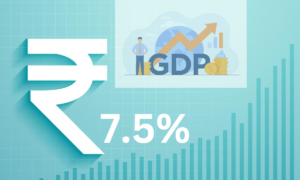GDP of India is predicted to increase by 7.3% in 2023–2024. The third consecutive year of growth rates above 7.5% in FY24, which comes amid challenging global conditions and a declining global economy, coincides with the anticipated March–April timing of this year’s national elections.

Although the first advance growth forecasts are significantly higher than the government’s initial growth estimate of 6.5%, they are only slightly higher than the 7.2% growth estimate for 2022–2023.
The increased GDP growth is thought to be supported by increased investment, government spending, and a pick-up in sectors outputs such as mining, manufacturing, construction, and financial services. There appears to be a slowdown in the hotel industry, transportation, trade, and communication services.
The Union Ministry of Finance and other departments release the first advance estimates of GDP early to assist in defining the general framework of the Union Budget for the upcoming fiscal year, which is scheduled to be presented in Parliament on February 1. The estimates are derived from the extrapolation of data from the first seven-eight months of the current fiscal year (FY24).
On February 29, the First Revised Estimates of National Income for 2022–2023 are scheduled for release. According to NSO, this could result in a modification to the growth rate of the First Advance Estimate for FY24.
The Reserve Bank of India (RBI) increased the real GDP growth prediction to 7% for FY24 in its December policy, although both the government and the RBI had previously predicted a growth rate of 6.5% for the fiscal year.
In FY24, it is anticipated that per capita real GDP would rise by 6.4%, while per capita net national income will rise by 6.3% to Rs 1.05 lakh from Rs 98,374 in the previous year. The real GDP growth per capita in the years prior to the pandemic averaged 5.3%. Furthermore, in real terms, per capita PFCE will increase by 3.5% in FY24. In contrast to the pre-pandemic era’s 5.5% per capita PFCE, the post-pandemic average is at 6.7%, according to a note by Soumya Kanti Ghosh, Group Chief Economic Adviser at State Bank of India.
In terms of industry growth, mining and quarrying is anticipated to increase to 8.1% from 4.6% in FY24, while manufacturing is predicted to grow at 6.5% in FY24 compared to 1.3% growth in the year prior. A double-digit growth rate of 10.7% is anticipated in the construction industry. However, compared to the previous year, when it grew by 4%, agricultural output is expected to drop down to 1.8% in 2023–2024.
The growth of the services sector is also expected to slow, from 9.5% growth in FY23 to 7.7% growth in FY24. Trade, hotels, transportation, and communication services are increasing at a slower rate of 6.3% in FY24 than 14% in FY23, while financial, real estate, and professional services are rising at 8.9%, up from 7.1% a year earlier.
This follows the Indian economy’s better-than-expected growth of 7.6% from July to September compared to 7.8% from April to June. Nonetheless, a slowdown is anticipated to persist in FY25 and is predicted by economists and the RBI for the final two quarters of the fiscal year.
The Indian economy is predicted to increase by 7% from October to March, which is less than the 7.7% growth predicted from April to September, based on back of the envelope calculations, with the first advance projections of GDP for FY24 standing at 7.3%. GDP estimates for the second half may be overly optimistic, according to economists.
The forecast for nominal GDP growth in 2023–2024, accounting for inflation, is 8.9%, a significant decrease from 16.1% due to the deflation in the wholesale price index (WPI), which is the basis for the GDP deflator. According to India Ratings, the annual GDP deflator growth is predicted to reach a 48-year low of 1.4% in 2023–24. This is anticipated to have an impact on the government’s estimates of the fiscal deficit because a nominal GDP growth of 10.5% was forecast in the Union Budget for 2023–2024.